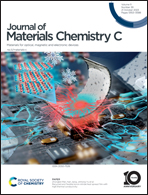Zero-bias Bi-based perovskite image sensor arrays with direct laser-scribing process†
Abstract
Bi-based halide perovskites have the characteristics of low toxicity, air stability, long carrier diffusion lifetime, and large light absorption coefficient, making them promising candidates for imaging sensors. However, existing approaches for preparing arrays still have challenges due to the sensitivity of Bi-based perovskites to polar solvents. Herein, we present 25 × 25 array devices based on Cs3Bi2Br9/GaN photodetectors (PDs) using a laser-scribing technique, which has the advantages of low cost, high accuracy, and being lithography-free. The optimized Cs3Bi2Br9/GaN PD showed outstanding self-powered photodetection capability with an ultralow dark current of 10−12 A under zero bias. Notably, the device exhibits remarkably weak light detection capability, enabling effective detection under 13.4 nW cm−2 illumination. In addition, the unencapsulated PD can maintain 95.1% of its initial performance after 5000 cycles of consecutive operation, and the device can perfectly follow light signals of different waveforms even after 3 months of storage in air, proving its excellent working stability. Finally, the arrays were used as sensors in an imaging system, and high-resolution imaging patterns were obtained. The results highlight a simple method for the fabrication of high-resolution imaging sensors and are expected to promote the development of low-cost and reliable imaging sensors.



 Please wait while we load your content...
Please wait while we load your content...